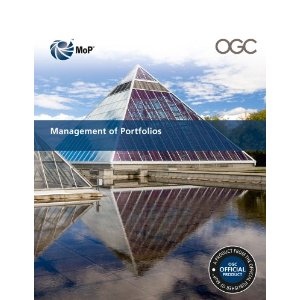Book review: Management of Portfolios
This blog is reader-supported. When you purchase something through an affiliate link on this site, I may earn some coffee money. Thanks! Learn more.
Read our review guidelines.

(MoP®) looks at—unsurprisingly—managing portfolios of projects and balancing organisational change.
So, what are portfolios and portfolio management? The book explains like this:
Portfolios represent the totality of an organisation’s investment (or segment thereof) in the changes required to achieve its strategic objectives. Portfolio management is a coordinated collection of strategic processes and decision that together enable a more effective balance or organisational change and business as usual. As such, portfolio management provides senior management with reliable evidence enabling better and more informed investment decisions.
Portfolio management includes managing resources, risk and dependencies appropriately. Its aim is to be a decision support function.
MoP® sets out 5 principles and 12 practices for successful portfolio management, split across the cycles of portfolio definition and portfolio delivery. Together, all this concentrates the organisational ‘energy’ on doing things well. There is a lot of talk about ‘energy’. It’s defined as “the extent to which an organisation, division or team has mobilised it emotional, cognitive and behavioural potential to pursue its goals.” Maybe ‘corporate focus’ would have been a better term.
Managing without bureaucracy
The book does include case studies and real-life examples. There is a clear desire to present portfolio management as non-bureaucratic and something that can be introduced even where programme and project management practices are not mature. However, some of the case studies don’t exactly demonstrate a non-bureaucratic approach. Take this one:
HMRC [HM Revenue and Customs] created an investment committee to make portfolio investment decisions, and a change delivery committee to monitor and assure delivery confidence. Each of these is chaired by a director general and includes director-level members, who can only sit on one committee. Formal links are maintained between the two committees by mandatory shared updates, drafted by chairs after each meeting. Additionally, each chair writes a post-meting report to the CEO for executive committee discussion.
I’m sure in large organisations this multi-level committee approach is practical and necessary.
Linking to an non-existent strategy
Ideally, portfolio management should link to strategic objectives. No strategy? No problem. MoP® sets out several techniques to deal with this including portfolio segmentation and pair-wise comparisons for making decisions.
The book goes to lengths to suggest that portfolio management is useful regardless of how messed up the rest of the organisation is. I know this is true, but I think that it would be a difficult message to present to executives.
There are some tools in the book that would contribute to that executive pitch, like prioritisation metrics, bubble and tornado reports and dashboards. This gives the book a good mix of both softer elements like collaborative working and hard skills of net present value, internal rate of return and payback.
If you are looking for a book that will convince you about the value of portfolio management, Simon Moore’s Strategic Project Portfolio Management is better. But if you want a book that will explain how to actually do portfolio management, MoP® is a great guide.
